It’s okay if you were a little confused when you first spotted the Mo-Fis, they don’t exactly look like a typical pair of headphones—unless you spend a lot of time in the pits at your local track. The folks at Blue took design cues from Formula 1 racecars and the human ear itself to develop headphones that are a little different from most.
When headphone companies focus so heavily on design there’s some concern that they may have sacrificed time that should’ve been spent on the audio quality. Luckily, Blue spent just as much time innovating on this front, including a built-in amp that should theoretically improve the sound quality when used with tablets, laptops, and smartphones that lack their own.
From both a design and technology standpoint, the Blue Mo-Fi over-ears are a bold move, especially for a first effort. And while the Mo-Fis aren’t perfect by any means, Blue is now a name to watch in the headphone space.
The Look
Is it a skeleton? Is it a piece of a robot? No! They’re Mo-Fis!
Whether the design is up your alley or not, there's no denying that these headphones have a very unique look. If you were to wear them out in public, you're almost guaranteed to get some glances from people as they pass by.
The design isn't just there for aesthetics, however, as the jointed band can expand to fit all types of head sizes and ear angles. A dial on top can be used to either increase or decrease the tension, as well, eliminating the pressure that can make overly tight over-ears uncomfortable over long listening sessions.
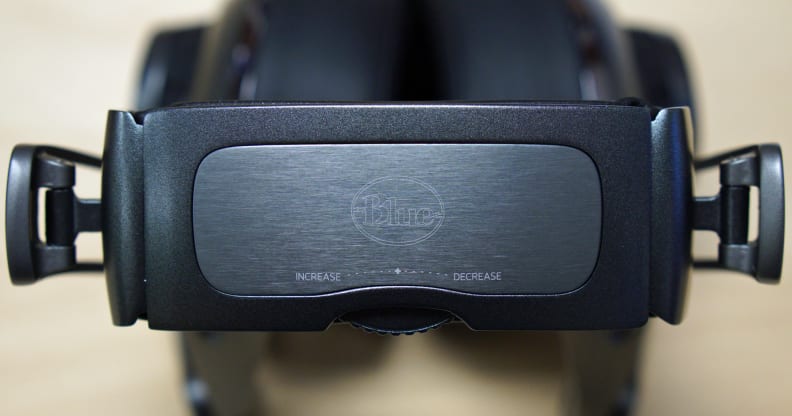
There is a dial on top of the headband to increase or decrease the tension for a comfortable fit.
Speaking of a comfortable fit, the earcups are big, shaped properly, and plush with a leather covering. They’ll completely encase your ears, isolating out some measure of ambient noise. There’s also plenty of room, so my ears could breathe and they never felt overheated or pressed too tightly against my head.
Blue didn’t skimp on the included accessories either. Inside the box you’ll find an incredibly soft carrying case, a four-foot audio cable with in-line controller for use with smartphones, a ten-foot plain audio cable, a USB charging cable, a 3.5mm to 1/4” adapter, and a two-prong airplane adapter. It seems like Blue wants to make sure you’re covered, no matter what scenario you find yourself in.
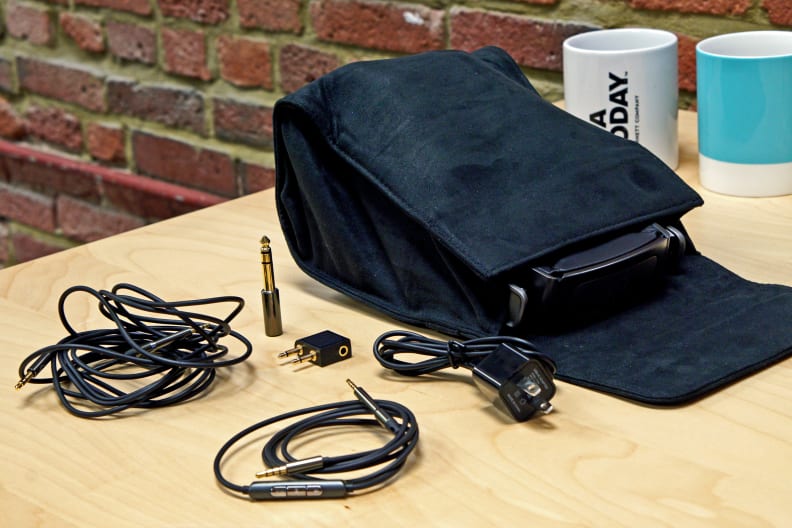
Blue Microphones included plenty of accessories in the box.
There is one big downside to all of the innovation crammed into the Mo-Fis. They’re absolutely enormous. Clocking in at 16.44oz (just over one pound) the Mo-Fis threw off the balance of my head whenever I wore them. It took some getting used to at first, but even after some time spent listening to music, if I tilted my head even a little, I could feel the Mo-Fis dragging my head further along.
And though the Mo-Fis are designed to improve on-the-go listening, that extra bulk can’t be folded down into something more portable. What you see is what you get with the Mo-Fis. And even though they came with a nice, velvety carrying case, these are definitely headphones that will live on your desk, either at home or in the office.
The Sound
The amp saves the day
There are two components to a great listening experience: the quality of your sound, and the quality of your equipment. While most shoppers tend to understand a little bit about the former, too often we focus on the headphones, forgetting one crucial component: power.
Most smartphones, tablets, and laptops don't include a built-in amplifier, so your music is never as full-throated as it was intended to be. You can pick up compact, external amps, but that's generally a cumbersome solution. The Mo-Fis solve this problem by including their own amp within the headphones.

There are three settings to control the amp—off, on, and on+.
On the side of the left earcup, right where the cable connects and disconnects, is a tiny toggle for the built-in amp. You can cycle between off, on, and on+, which applies a boost to bass-heavy tracks. The amp charges via micro-USB, with its own built-in battery; If it dies you’ll still be able to listen to music, it just won’t have the same boosted performance that you’ll quickly get used to.
During normal listening, the amp drastically improved the sound quality from the Mo-Fis. In fact, when the amp died I found myself much more likely to stop listening to music to charge the Mo-Fis instead of pressing on without it.
One Blue-provided tip: When you start listening to music, you’ll want to mute your device and slowly increase the volume from zero, especially if the amp is turned on. They're not kidding, either; If I tried raising the volume anywhere above the 50 percent mark the volume was just unbearably loud.
In addition to the amp, Blue also included 50mm drivers in the build. These enormous drivers are capable of delivering a ton of impressive sound on their own, but when paired with the amp, they truly shine.
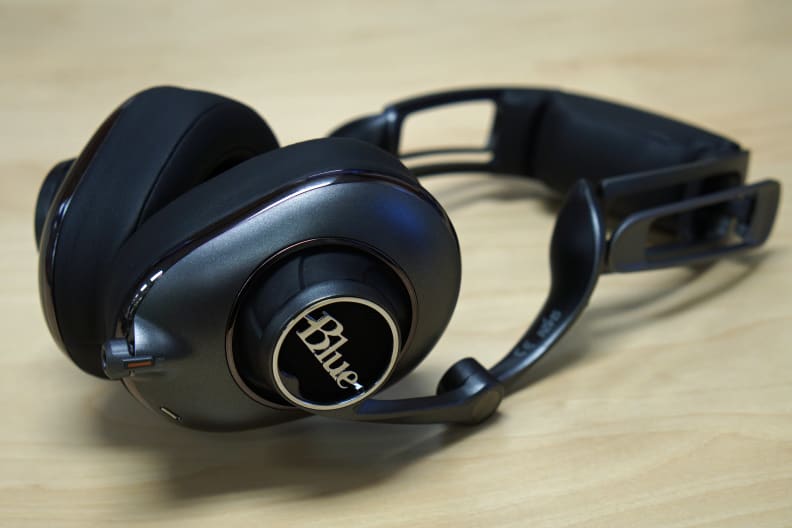
Even fully extended, the Mo-Fis look like something out of science fiction.
We measured a frequency response that was relatively flat across the audible spectrum, from sub-bass to high frequencies. There are plenty of headphones on the market that boost bass to tremendous levels, but that kind of sound isn’t for everybody. Instead, the Mo-Fis are going to do wonders if you plan on using them in a studio or at home to equalize your own music.
When it comes to passive isolation the Mo-Fis perform admirably enough. They won’t be able to block any of the deep bass sounds from bus or train engines, but they lower the relative volume of midrange sounds (which make up the bulk of daily sounds you’re likely to encounter anyway) by about 25–50 percent; not enough to completely cut them out, but enough that they won’t be as much of a nuisance.
But, when you play music—especially with the amp turned on—the so-so isolation simply isn't an issue, as your music will handily overpower whatever ambient noise may have been bothering you.
The extra padding around the earcups and the tight, ergonomic seal created by that padding, are also effective at stopping any of your music from leaking out and annoying those around you. A blessing when you consider how much sound the Mo-Fis are capable of producing.
There’s some bad news if enjoy music that has plenty of chest-thumping bass. When we tested for distortion—the audible fuzzy, crackling sounds that can infect your music—we found that the Mo-Fis have enough in the sub bass and bass range that you’re definitely going to notice.
The Verdict
You already know if these are for you
When it comes down to it, the Mo-Fis aren’t the best headphones on the market right now, a fact that shouldn’t be surprising considering it’s Blue’s first attempt at headphones. They're loud, of course, but there are enough small issues that strict audiophiles will probably prefer something more accurate.
We'll say this for Blue, though: with a unique look, a genuinely innovative design, and above-average sound-quality the Mo-Fis are definitely on the right track.
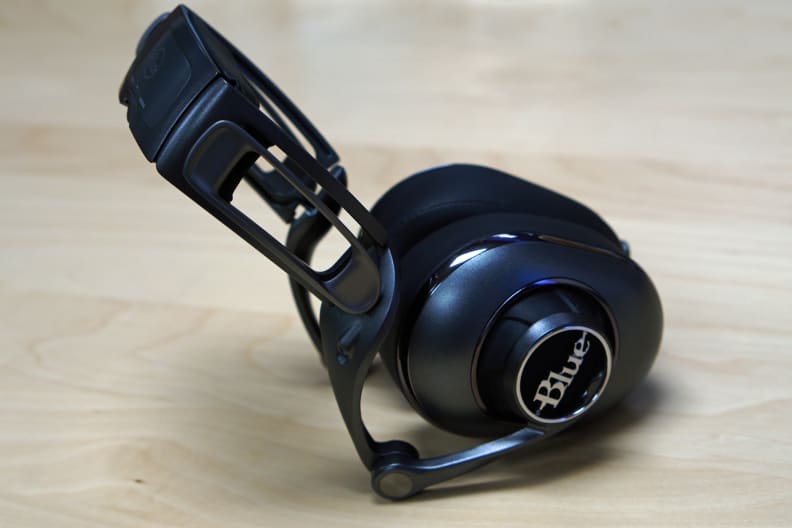
Blue is challenging the status quo by using a unique design.
If you want to spend a little less money and would like more control over your headphones' look and sound, we’d recommend the Beyerdynamic Custom One Pros (MSRP: $229.00). They’ve been our top-rated headphones for two years running now, and for the price of admission you get plenty of customization options, both for the sound and the design. You can even find deals online that price them closer to $140.
But, the Custom One Pros don’t come with a built-in amp or those enormous 50mm drivers, nor do they excel in the looks department. For a conversation piece, that still manages to sound great, the Mo-Fis are in a category all their own.
The Insides That Count
While Blue Microphones obviously spent a lot of time working on the design of the Blue Microphone Mo-Fis (MSRP: $349.99), that doesn’t mean they skimped on the sound. A built-in amplifier and 50mm drivers, in theory, should be more than enough to deliver a ton of sound.
But, that amp comes at a price and in this case that price lies in the distortion levels. Otherwise, you’re looking at a decent pair of headphones with a relatively flat frequency response and isolation that isn’t terrible, but isn’t amazing either.
Frequency Response
Using a 78dB parent signal, we measured the output of the Mo-Fis and determined how they managed frequencies across the audible spectrum.

The frequency response data is relatively flat, which is great if you plan on equalizing your own music.
From sub bass to bass (0–300Hz), the sound sticks relatively closely to about 78dB, the same volume that we used for our parent signal. Going into the midrange (300-2kHz) however, there was a sharp drop at about 500Hz that brought the level to 70dB before it came back up to somewhere closer to 74dB.
These levels stay steady for the rest of the midrange frequencies until 2kHz when the sound enters the high mids (2–6kHz). At this point there is a sharp drop that goes to about 60dB before going back up to 70dB and dropping again. The high frequencies (6–20kHz) suffer from a few peaks and valleys that will only be noticeable with songs that have a lot of high notes, like classical music.
Distortion

Distortion was another problem area for the Mo-Fi, between the three modes, the best scores we got still reached as high as 20% at some frequencies.
The distortion of the Mo-Fis didn’t quite live up to our expectations. We tested them with each of the different amp settings—off, on, on+—and it turned out that having it set to on produced the best results. In the sub bass range (0–60Hz) the levels reach upwards of 20%. But, while anything above 3% is audible to the average person, the lower end of the spectrum is the most difficult range to pick up distortion, so while you should hear some fuzzy, crackling sounds, it probably won’t be as pronounced as this chart seems to indicate.
Going past the sub-bass range and into the rest of the audible spectrum, the Mo-Fis perform much better and stick closer to 2–3%, which is just on that brink of being audible to the average listener.
Isolation
The Mo-Fis performed on average with other headphones when we tested isolation. They weren’t able to block out a ton of sound, but they certainly aren't the worst we’ve ever seen.
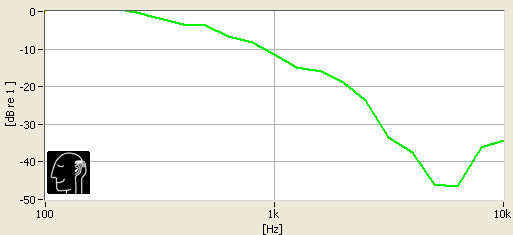
The Mo-Fis have a fair amount of passive isolation, just don't expect deep bass sounds to be blocked completely.
The Mo-Fis are unable to lower the relative volume of sub bass and bass sounds (100–300Hz) by any kind of significant amount. While their size should already preclude these from being commuter headphones, their inability to block the sounds of engines effectively definitively puts them on your desk—either at home or in the office.
Moving further down the frequency chart, the Mo-Fis start to pick up in their ability to lower the volume of ambient sound. In the midrange (300Hz–2kHz), the relative volume is lowered somewhere between 25 and 50 percent. Considering this is where the majority of sound you’re likely to encounter lives, this isn’t bad at all.
Going past the midrange and into the high mids and high frequencies (2–6kHz and 6–20kHz), the relative volume drops from about a quarter as loud to somewhere closer to 1/16 or 1/32 the original volume. Unfortunately, there aren't a whole lot of ambient sounds that live in this range that you’re likely to run into.
Other Tests
{{ photo_gallery name="Other" }}
Meet the tester
Coming from Buffalo, NY, Nick studied media production and arts journalism. When he’s not writing about tech Nick can be found playing video games and keeping up on the latest in pop culture.
Checking our work.
Our team is here to help you buy the best stuff and love what you own. Our writers, editors, and experts obsess over the products we cover to make sure you're confident and satisfied. Have a different opinion about something we recommend? Email us and we'll compare notes.
Shoot us an email

